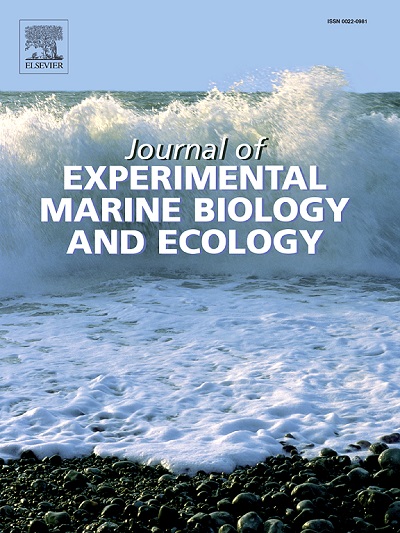寄生虫聚集:雌性吸引同种的雄性寄主在体外寄生的等足类卵异卵蛇
IF 1.8
3区 生物学
Q3 ECOLOGY
Journal of Experimental Marine Biology and Ecology
Pub Date : 2025-05-10
DOI:10.1016/j.jembe.2025.152106
引用次数: 0
摘要
对于海洋无脊椎动物的共生体来说,为了寻找配偶而在宿主之间迁徙会带来各种各样的生态困难。寄主聚集是共生体有时用来克服这种挑战的一种行为特征。这可以增加交配机会,这取决于交配和性系统。本研究通过为期2年的野外调查,研究了雌雄同体异寄生等足动物卵异隐足鼠(Onisocryptus ovalis)对寄主介形虫hilgendorfii Vargula的季节性偏向。此外,我们还通过实验室实验证明了雄性等足类动物的寄主偏好。寄生等足类在春季、初夏和秋季聚集在较大和雌性介形虫寄主上。在实验室实验中,可以在宿主之间移动的雄性寄生虫始终表现出对被同寄生雌性寄生的宿主介形虫的偏好,而不是没有同寄生雌性寄生的宿主。雄性等足类寄生虫可能会选择较大的雌性寄主,雌性寄主主要可以为雌性等足类寄生虫提供更多的卵作为生殖资源。此外,雄性寄生虫更喜欢被雌性同种寄生虫寄生的宿主。在遇到配偶的机会有限的情况下,这种偏好和雌雄同体的性系统可能会增加寄生等足类动物的繁殖成功率。因此,寄生等足类动物的这些特征会产生季节性聚集,同时受寄主越冬、招募和繁殖生活史的影响。本文章由计算机程序翻译,如有差异,请以英文原文为准。
Parasite aggregations: Females attract conspecific males to the hosts in the ectoparasitic isopod Onisocryptus ovalis
For symbionts of marine invertebrates, migration between hosts for mate-searching entails various ecological difficulties. Aggregation in hosts is a behavioral feature sometimes employed by symbionts to overcome such challenges. This can increase mating opportunities, depending on the mating and sexual systems. In this study, we investigated seasonal bias in the ectoparasitic isopod Onisocryptus ovalis, a protandrous hermaphrodite, toward the host ostracod Vargula hilgendorfii using a two-year field survey. We additionally demonstrated the host preference of male isopods through laboratory experiments. Parasitic isopods aggregated on larger and female ostracod hosts in the field during spring, early summer, and sometimes autumn. In laboratory experiments, male parasites, which can move between hosts, consistently showed a preference for host ostracods parasitized by conspecific females compared to hosts without conspecifics. Male parasitic isopods likely select larger female hosts, which can mainly serve more eggs as reproductive resources for female parasitic isopods. Male parasites, in addition, prefer hosts parasitized by female conspecifics. Such preferences and the sexual system of protandrous hermaphrodites may increase the reproductive success of parasitic isopods under limited opportunities to encounter mates. Therefore, these traits of parasitic isopods would produce seasonal aggregation while being influenced by the life history of the hosts associated with overwintering, recruiting, and reproduction.
求助全文
通过发布文献求助,成功后即可免费获取论文全文。
去求助
来源期刊
CiteScore
4.30
自引率
0.00%
发文量
98
审稿时长
14 weeks
期刊介绍:
The Journal of Experimental Marine Biology and Ecology provides a forum for experimental ecological research on marine organisms in relation to their environment. Topic areas include studies that focus on biochemistry, physiology, behavior, genetics, and ecological theory. The main emphasis of the Journal lies in hypothesis driven experimental work, both from the laboratory and the field. Natural experiments or descriptive studies that elucidate fundamental ecological processes are welcome. Submissions should have a broad ecological framework beyond the specific study organism or geographic region.
Short communications that highlight emerging issues and exciting discoveries within five printed pages will receive a rapid turnaround. Papers describing important new analytical, computational, experimental and theoretical techniques and methods are encouraged and will be highlighted as Methodological Advances. We welcome proposals for Review Papers synthesizing a specific field within marine ecology. Finally, the journal aims to publish Special Issues at regular intervals synthesizing a particular field of marine science. All printed papers undergo a peer review process before being accepted and will receive a first decision within three months.

 求助内容:
求助内容: 应助结果提醒方式:
应助结果提醒方式:


